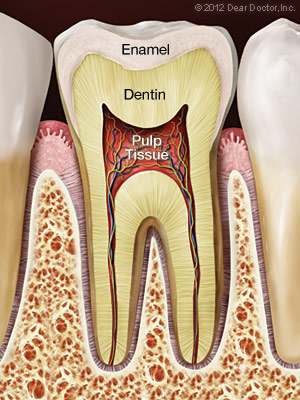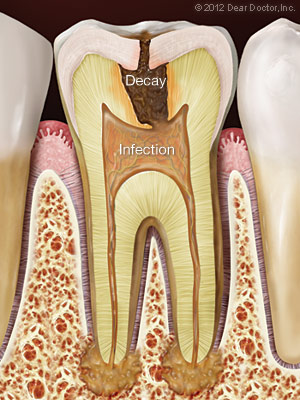
Persistent pain in the area around a single tooth may indicate that it is extremely infected or decayed. The good news is Lancaster dentist Dr. Douglas B. Weber at Douglas B. Weber, D.D.S. can often relieve discomfort quickly with a root canal treatment, saving a tooth that is severely damaged. Though the term “root canal” has a notorious association with pain, with all of the advances in the field of dental care and pain management, receiving a root canal treatment is now a comfortable and efficient way to preserve and restore your oral health.
When Is a Root Canal Treatment Needed?
When decay and infection cause damage to the nerve and pulp of a tooth, a root canal treatment is performed. Common symptoms that indicate a possible need for root canal treatment are:
- Consistent pain (may include throbbing) in the tooth area
- Pain caused by the pressure of chewing or as an extended reaction to contact with hot and cold temperatures
- Tender, swollen gums
- Discoloration
- The appearance of a pimple on the gums
What Is a Root Canal Treatment?
During a root canal, Dr. Weber gently removes your tooth’s damaged tissue and nerves, then carefully cleans and seals the tooth to protect it from bacteria. The procedure may require more than one visit, depending on the severity of the infection and the type of restoration — typically a filling or a crown — that is needed.
What Can I Expect My Root Canal Recovery to Be Like?
You will experience instant pain relief after your root canal treatment. During your root canal recovery, chewing on the affected side of the mouth should be avoided until the filling or final restoration is completed. Your tooth may be sensitive for a couple of days following the procedures. Any discomfort you experience can be easily managed through the use of over-the-counter pain medications such as ibuprofen. Your oral health routine should continue as usual and should include brushing, flossing, and rinsing.
The root canal treatment has a success rate of 95% and can last a lifetime.
FAQ
Q. Is a root canal painful?
A. In most cases, receiving a root canal treatment feels like receiving a filling — and at Douglas B. Weber, D.D.S., we offer comfort options that eliminate pain and induce a serene, relaxed state while we perform this simple procedure.
Q. Is a root canal the same as a filling?
A. A filling is a less extensive procedure than a root canal and only requires the removal of decay from the tooth’s surface. During a root canal, the damaged tooth pulp and nerve are removed before the filling or other restorations are applied.



